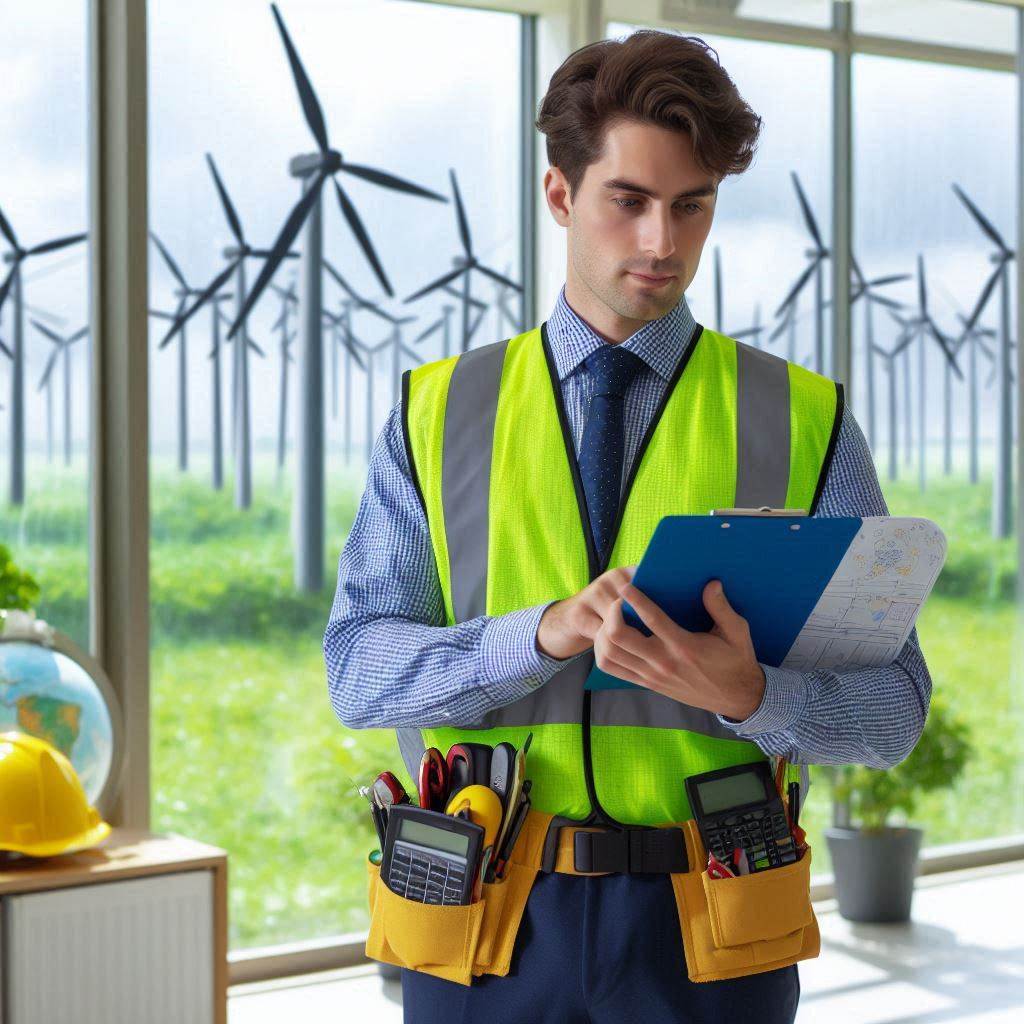Introduction
Environmental engineering is a discipline focused on developing and implementing solutions to address various environmental challenges.
This field applies scientific principles and engineering techniques to manage and mitigate issues related to air, water, and soil pollution.
Environmental engineers design systems for waste treatment, pollution control, and resource management, aiming to protect human health and the environment.
Their work involves creating technologies and processes that improve the quality of natural resources and ensure sustainable use.
Sustainable development, on the other hand, is a broader concept that seeks to balance economic growth, environmental protection, and social equity.
It involves meeting the needs of the present generation without compromising the ability of future generations to meet their own needs.
This approach emphasizes long-term planning and the responsible use of resources to ensure that development is both environmentally friendly and economically viable.
The importance of these fields in addressing environmental issues cannot be overstated.
Environmental engineering provides the tools and techniques needed to tackle specific environmental problems, such as waste management, air and water pollution control, and climate change mitigation.
These engineers develop innovative solutions to reduce the negative impacts of human activities on the environment, ensuring that natural resources are used efficiently and sustainably.
Overview of Environmental Engineering
Role of Environmental Engineers in Designing
Environmental engineers play a crucial role in addressing environmental problems through innovative design and implementation.
They focus on developing solutions for issues like pollution control, waste management, and resource conservation.
In designing these solutions, environmental engineers use scientific principles to create systems and technologies that reduce environmental impact.
For instance, they design advanced wastewater treatment facilities to remove contaminants from sewage.
This ensures that treated water meets safety standards before being released back into natural water bodies.
Similarly, they develop air pollution control systems to filter out harmful emissions from industrial processes, improving air quality.
Implementation involves applying these designs in real-world settings.
Environmental engineers oversee the construction and operation of these systems, ensuring they function as intended.
They work closely with construction teams and facility managers to troubleshoot issues and optimize performance.
Monitoring is another critical aspect of their role.
Environmental engineers continuously track the effectiveness of their solutions.
They collect and analyze data to ensure compliance with environmental regulations.
This includes regular inspections and performance evaluations to confirm that systems are operating efficiently.
Interdisciplinary Nature of Environmental Engineering
Environmental engineering is inherently interdisciplinary, combining principles from various fields to address complex environmental challenges.
This interdisciplinary approach integrates knowledge from chemistry, biology, geology, and engineering.
For example, understanding chemical processes is essential for designing effective water treatment systems.
Environmental engineers must apply chemistry to remove pollutants and ensure safe water quality.
Similarly, biological principles are crucial for developing waste management systems that utilize natural processes to break down organic matter.
Geology plays a role in assessing soil and groundwater conditions.
Engineers need to understand geological formations to manage landfills and prevent contamination of water sources.
The integration of these disciplines allows environmental engineers to approach problems from multiple angles, creating more effective and sustainable solutions.
Moreover, environmental engineers often collaborate with professionals from other fields, such as urban planners and policy makers.
This collaboration ensures that their solutions align with broader sustainability goals and regulatory requirements.
For instance, when planning new infrastructure projects, they work with urban planners to minimize environmental impacts and enhance resilience to climate change.
Therefore, environmental engineers are pivotal in designing, implementing, and monitoring solutions to environmental problems.
Their work involves not only engineering expertise but also knowledge from other scientific disciplines.
This interdisciplinary approach enables them to tackle complex issues effectively and contribute to sustainable development.
By integrating diverse fields of study and collaborating with various professionals, environmental engineers create innovative solutions that address both current and future environmental challenges.
Key Concepts in Sustainable Development
Sustainable development is a framework designed to address current needs while safeguarding future generations.
It focuses on creating solutions that balance social, economic, and environmental considerations.
This approach ensures that growth and progress do not come at the expense of the planet or people.
Sustainable development aims to integrate these three pillars to achieve a harmonious and equitable world.
Social Pillar
The social pillar emphasizes the well-being and equity of all people.
It involves promoting human rights, improving quality of life, and ensuring access to essential services such as education and healthcare.
Sustainable development seeks to build inclusive societies where every individual can thrive.
This pillar addresses issues like poverty, inequality, and social justice.
It aims to create communities that are resilient, diverse, and capable of meeting the needs of their members.
Economic Pillar
The economic pillar focuses on creating prosperity and ensuring long-term economic stability.
It involves fostering economic growth that is both inclusive and sustainable.
This pillar supports efficient use of resources, innovation, and fair trade practices.
Sustainable development promotes practices that enhance economic productivity while reducing environmental impact.
It aims to create economies that are resilient to changes and capable of supporting a high quality of life for all.
Environmental Pillar
The environmental pillar is concerned with protecting natural resources and ecosystems.
It focuses on minimizing pollution, conserving biodiversity, and managing resources sustainably.
This pillar addresses issues like climate change, deforestation, and resource depletion.
Sustainable development requires integrating environmental considerations into decision-making processes.
It aims to reduce the ecological footprint of human activities and promote practices that support the health of the planet.
Present needs without compromising future generations
Sustainable development strives to meet present needs without compromising the ability of future generations to meet their own needs.
It involves making choices that do not deplete resources or damage ecosystems.
By focusing on long-term impacts, sustainable development encourages practices that ensure resources remain available and ecosystems continue to function.
This approach aims to create a balance where economic, social, and environmental goals are achieved together.
For example, implementing renewable energy sources reduces reliance on fossil fuels and decreases greenhouse gas emissions.
This approach benefits both current and future generations by promoting cleaner energy and reducing climate change impacts.
Similarly, sustainable agricultural practices conserve soil and water, ensuring food security for future populations.
Sustainable development integrates these pillars to create a balanced approach to growth and resource management.
By addressing social, economic, and environmental factors, we can build a future that supports the well-being of all people and the health of our planet.
This holistic approach is essential for creating a resilient and equitable world.
Read: Decoding the Ethics & Responsibilities of US Civil Engineers
Environmental Challenges Faced Today
Identify and Discuss Major Environmental Issues
Environmental engineers address significant environmental issues such as climate change, air and water pollution, deforestation, and waste management.
Climate change remains a pressing concern due to its widespread impacts.
Greenhouse gas emissions, primarily from burning fossil fuels, contribute to global warming.
This results in rising temperatures, melting ice caps, and extreme weather events.
Air pollution, caused by industrial emissions and vehicle exhaust, presents another major issue.
Harmful pollutants like sulfur dioxide, nitrogen oxides, and particulate matter degrade air quality.
Poor air quality leads to respiratory problems, cardiovascular diseases, and other health issues.
Water pollution, from agricultural runoff and industrial discharge, contaminates water bodies.
Pollutants like pesticides, heavy metals, and plastics threaten aquatic life and human health.
Contaminated water sources can spread diseases and disrupt ecosystems.
Deforestation, driven by logging and agricultural expansion, results in habitat loss and reduced biodiversity.
Forests play a crucial role in carbon sequestration and regulating the water cycle.
Their destruction contributes to climate change and disrupts ecosystems.
Waste management is another critical issue.
Improper disposal of waste leads to soil and water contamination.
Landfills release methane, a potent greenhouse gas, while plastic waste pollutes oceans and harms marine life.
Effective waste management practices, including recycling and composting, are essential for mitigating these impacts.
Illustrate the Impact of These Challenges on Human Health and the Environment
Climate change has far-reaching consequences for both human health and the environment.
Rising temperatures increase the frequency and intensity of heatwaves, posing health risks, especially to vulnerable populations.
Extreme weather events, like hurricanes and floods, cause widespread damage and displacement.
These events also strain emergency response systems and resources.
Air pollution has severe health implications.
Long-term exposure to polluted air can cause chronic respiratory conditions, lung cancer, and heart disease.
Children and the elderly are particularly vulnerable to the effects of poor air quality.
Additionally, air pollution can damage crops, reduce agricultural productivity, and harm wildlife.
Water pollution affects both humans and the environment.
Contaminated water can spread waterborne diseases, such as cholera and dysentery.
Polluted water bodies disrupt aquatic ecosystems, leading to the death of fish and other marine organisms.
This loss of biodiversity impacts food chains and overall ecosystem health.
Deforestation contributes to climate change and biodiversity loss.
Forests act as carbon sinks, absorbing carbon dioxide from the atmosphere.
Their destruction releases stored carbon, exacerbating global warming.
Loss of forests also reduces habitats for countless species, pushing many towards extinction.
This loss of biodiversity affects ecosystem stability and resilience.
Improper waste management leads to environmental degradation.
Landfills leach harmful chemicals into the soil and water, contaminating them.
Methane emissions from landfills contribute to climate change.
Plastic waste in oceans entangles marine life and disrupts ecosystems.
Effective waste management practices are crucial for reducing these impacts.
Read: Top Cities for Electrical Engineering Jobs in America
Strategies for Sustainable Development
When it comes to sustainable development, there are various strategies and approaches that can be employed to achieve positive outcomes.
These strategies focus on long-term environmental, social, and economic benefits. Below are some key strategies for sustainable development:
Green Technologies
Green technologies play a vital role in promoting sustainable development by reducing carbon emissions, increasing energy efficiency, and minimizing waste generation.
These technologies harness renewable resources to meet the needs of the present without compromising the ability of future generations to meet their own needs.
For example, solar panels, wind turbines, and geothermal systems are all examples of green technologies that contribute to sustainable development.
Renewable Energy
One of the most important strategies for sustainable development is the transition to renewable energy sources.
Renewable energy, such as solar, wind, hydroelectric, and biomass, is inexhaustible and environmentally friendly.
By investing in renewable energy infrastructure, countries can reduce their dependence on fossil fuels, lower greenhouse gas emissions, and create new job opportunities in the clean energy sector.
For instance, countries like Germany and Denmark have made significant investments in renewable energy, leading to a decrease in their carbon footprint and a more sustainable energy supply.
Resource Conservation
Resource conservation is another critical strategy for sustainable development.
By minimizing waste generation, recycling materials, and using resources efficiently, countries can reduce their environmental impact and preserve natural resources for future generations.
Industries can adopt sustainable practices such as water recycling, energy-efficient manufacturing processes, and sustainable sourcing of raw materials to minimize their environmental footprint.
For example, companies like Patagonia and Interface have implemented resource conservation practices in their operations, leading to reduced waste generation and lower resource consumption.
Examples of Successful Sustainable Development Projects
There are several successful sustainable development projects from around the world that serve as models for achieving environmental, social, and economic sustainability.
These projects demonstrate the effectiveness of implementing sustainable strategies and the positive impact they can have on communities and the environment.
Below are some examples of successful sustainable development projects
Masdar City, United Arab Emirates
Masdar City is a planned sustainable urban development in Abu Dhabi, United Arab Emirates.
It aims to be one of the most sustainable cities in the world, with a focus on renewable energy, resource conservation, and green technologies.
The city is designed to be car-free, with pedestrian-friendly streets, efficient public transportation systems, and renewable energy-powered buildings.
Masdar City serves as a model for sustainable urban planning and development, showcasing the integration of green technologies and sustainable practices in city design.
The High Line, New York City, USA
The High Line is a successful example of sustainable urban regeneration in New York City.
It is a public park built on a historic freight rail line elevated above the streets on Manhattan’s West Side.
The project transformed an abandoned railway into a green public space that promotes biodiversity, community engagement, and sustainable urban design.
The High Line demonstrates how underutilized urban spaces can be repurposed to create green infrastructure and enhance the quality of life in cities.
Three Gorges Dam, China
The Three Gorges Dam is one of the world’s largest hydropower projects, located on the Yangtze River in China.
The dam generates renewable energy, reduces flood risk, and improves navigation in the region.
While controversial due to its environmental and social impacts, the project demonstrates how sustainable development can balance economic growth with environmental protection.
The Three Gorges Dam highlights the importance of considering the long-term consequences of large-scale infrastructure projects and implementing mitigation measures to minimize negative impacts.
Transform Your Career Today
Unlock a personalized career strategy that drives real results. Get tailored advice and a roadmap designed just for you.
Start NowIn fact, sustainable development is essential for ensuring a harmonious relationship between human activities and the environment.
By adopting strategies such as green technologies, renewable energy, and resource conservation, countries can achieve sustainable economic growth while protecting the planet for future generations.
Successful sustainable development projects around the world serve as inspiration for implementing sustainable practices and creating a more sustainable future for all.
Read: US Tech Hubs Beyond Silicon Valley: Emerging Cities

Role of Environmental Engineers in Sustainable Development
How environmental engineers play a crucial role in promoting sustainable development
Environmental engineers play a crucial role in promoting sustainable development.
Their expertise helps ensure that projects balance environmental, economic, and social goals.
By focusing on sustainable practices, they contribute significantly to long-term environmental health and resource management.
Designing Sustainable Infrastructure
Environmental engineers are integral to designing sustainable infrastructure.
They work on projects like green buildings, renewable energy systems, and eco-friendly transportation networks.
Their designs often incorporate energy-efficient technologies, sustainable materials, and waste-reducing features.
By prioritizing sustainability, they help minimize the environmental footprint of new constructions.
Engineers use principles of sustainable design to enhance resource efficiency and reduce operational impacts.
Their work ensures that infrastructure projects support environmental conservation while meeting societal needs.
Managing Natural Resources
Effective management of natural resources is another critical area where environmental engineers make a difference.
They develop strategies for sustainable water use, soil conservation, and waste management.
Engineers design systems for water recycling, stormwater management, and soil restoration.
Their expertise helps prevent resource depletion and promotes the responsible use of natural assets.
By implementing innovative technologies and practices, they support the preservation of ecosystems and maintain the health of natural resources.
Their efforts ensure that current and future generations can enjoy a stable and sustainable environment.
Mitigating Environmental Impact
Mitigating environmental impact is a fundamental aspect of environmental engineering.
Engineers assess the potential effects of projects on air, water, and soil quality.
They develop and implement strategies to minimize pollution, manage waste, and protect wildlife habitats.
Their work involves creating solutions for reducing emissions, treating contaminated sites, and enhancing environmental quality.
By addressing these issues, environmental engineers help prevent ecological damage and promote environmental resilience.
Their actions support broader sustainability goals by ensuring that human activities have minimal negative effects on the environment.
Environmental engineers play a crucial role in sustainable development through their involvement in designing sustainable infrastructure, managing natural resources, and mitigating environmental impact.
Their expertise helps create solutions that balance environmental conservation with societal progress.
By focusing on sustainability, they contribute to long-term environmental health and resource management.
Their efforts support the development of infrastructure that meets current needs while preserving resources for future generations.
Environmental engineers are essential to advancing sustainable practices and achieving global sustainability goals.
Read: From Intern to Lead: Climbing the Software Ladder in the US
Case Studies in Environmental Engineering and Sustainable Development
Successful Environmental Engineering Projects That Have Contributed to Sustainable Development
Case Study 1: Singapore’s Marina Barrage
Singapore’s Marina Barrage is a prime example of successful environmental engineering.
Built across the Marina Channel, this project creates a freshwater reservoir while providing flood control and a recreational space.
Engineers designed the barrage to manage the city’s water supply, mitigate flooding, and enhance urban quality of life.
It has helped Singapore achieve water sustainability by addressing the nation’s water scarcity issues.
Case Study 2: The Three Gorges Dam in China
The Three Gorges Dam in China represents another monumental environmental engineering project.
This hydroelectric dam on the Yangtze River is the world’s largest power station by installed capacity.
It generates renewable energy, reduces greenhouse gas emissions, and manages flood control.
Despite its environmental and social challenges, the dam significantly contributes to China’s energy sustainability and flood management.
Case Study 3: Curitiba’s Bus Rapid Transit (BRT) System
Curitiba, Brazil, showcases sustainable urban planning with its innovative Bus Rapid Transit (BRT) system.
Environmental engineers designed the BRT to reduce traffic congestion, lower emissions, and improve public transportation efficiency.
The system has revolutionized public transport in Curitiba, reducing pollution and enhancing mobility for residents.
It serves as a model for cities worldwide aiming for sustainable urban transport solutions.
Case Study 4: The Thames Tideway Tunnel in London
London’s Thames Tideway Tunnel is a critical infrastructure project addressing sewage overflow into the River Thames.
Environmental engineers are constructing a 25-kilometer tunnel to capture and store excess sewage and rainwater.
This project will improve water quality, reduce pollution, and protect aquatic life in the Thames.
It represents a significant step towards sustainable urban water management.
Outcomes and Impact of These Projects on the Environment and Society
Marina Barrage
The Marina Barrage project has transformed Singapore’s water management landscape.
It provides a reliable freshwater supply, reducing the city’s dependence on imported water.
The barrage also offers flood protection and recreational opportunities, enhancing the quality of urban life.
Its success in water sustainability demonstrates the impact of well-planned environmental engineering.
Three Gorges Dam
The Three Gorges Dam has significantly impacted China’s energy landscape.
It generates clean, renewable energy, reducing reliance on coal and cutting carbon emissions.
The dam also provides flood control, protecting millions of people from flood risks.
However, it has also displaced communities and affected ecosystems, highlighting the need for balanced environmental engineering.
Curitiba’s BRT System
Curitiba’s BRT system has transformed urban transportation.
It has reduced traffic congestion, lower greenhouse gas emissions, and improved air quality.
The efficient public transport system has enhanced mobility, making commuting more accessible and sustainable.
This project exemplifies how environmental engineering can address urban challenges and promote sustainable development.
Thames Tideway Tunnel
The Thames Tideway Tunnel project will significantly improve London’s water quality.
It will reduce sewage overflows, protecting the River Thames and its ecosystems.
The tunnel will enhance public health by reducing waterborne diseases and pollution.
Its impact on urban water management underscores the importance of sustainable infrastructure projects.
In essence, these case studies demonstrate how environmental engineering projects contribute to sustainable development.
Through innovative designs and sustainable practices, these projects positively impact the environment and society, promoting a sustainable future.
Challenges and Future Directions
Challenges Faced by Environmental Engineers and Sustainable Development Practitioners
Environmental engineers and sustainable development practitioners face several challenges in their work, which can hinder the progress towards a greener and more sustainable future.
Some of the key challenges include
- Lack of Funding: One of the major obstacles is the shortage of funding for projects and research in environmental engineering and sustainable development.
- Policy Barriers: Oftentimes, outdated policies and regulations can impede the implementation of new technologies and sustainable practices.
- Public Perception: There is a lack of awareness and understanding among the general public about the importance of environmental issues and sustainable development.
Potential Solutions and Future Directions for Advancing Environmental Engineering and Sustainable Development
In order to overcome these challenges and move towards a more sustainable future, it is essential to consider the following potential solutions and future directions
Showcase Your Business Today
Reach thousands of readers actively exploring professional services. Publish your business profile and grow your audience now.
Publish Now- Increased Funding: Governments, private organizations, and individuals need to allocate more resources towards environmental engineering and sustainable development initiatives.
- Policy Reform: There is a need for policymakers to update and create new regulations that support and encourage environmentally-friendly practices and technologies.
- Public Education and Engagement: It is crucial to raise awareness among the public about the importance of sustainability and involve them in decision-making processes.
- Technological Innovation: Investing in research and development of new technologies is essential for advancing environmental engineering and sustainable development.
- Collaboration and Partnerships: Building partnerships between different stakeholders, including government agencies, industries, academia, and communities, can lead to more effective solutions.
- Integration of Sustainability into Education: Incorporating sustainability principles into education curricula can help create a new generation of professionals who are committed to environmental stewardship.
- Monitoring and Evaluation: Continuous monitoring and evaluation of projects and initiatives are necessary to ensure that they are effective and align with sustainability goals.
By addressing these challenges and implementing the proposed solutions, environmental engineers and sustainable development practitioners can make significant progress towards creating a more sustainable and resilient future for generations to come.
Conclusion
Environmental engineering is pivotal in tackling global environmental challenges and advancing sustainable development.
This field integrates engineering principles with environmental science to address issues like pollution, resource depletion, and habitat destruction.
By developing innovative solutions, environmental engineers work to mitigate negative impacts on ecosystems and human health.
Sustainable development focuses on meeting the needs of the present without compromising future generations.
It involves creating systems that are efficient, resilient, and environmentally friendly.
Environmental engineering contributes significantly to this goal by designing technologies and processes that reduce waste, conserve energy, and promote the use of renewable resources.
Understanding the role of environmental engineering in sustainable development is essential for everyone.
Readers are encouraged to delve deeper into how this field shapes our approach to environmental challenges.
Exploring educational resources, engaging in relevant projects, and considering careers in environmental engineering can all contribute to a more sustainable future.
By staying informed and involved, individuals can make meaningful contributions to sustainability.
Whether through supporting green technologies, advocating for environmental policies, or practicing sustainable habits, every action helps build a healthier planet.
Environmental engineering offers diverse opportunities to make a positive impact, and learning more about this field can inspire meaningful involvement.
[E-Books for Sale]
The Big Book of 500 High-Paying Jobs in America: Unlock Your Earning Potential
$19.99 • 500 High-Paying Jobs • 330 pages
Explore 500 high-paying jobs in America and learn how to boost your career, earn more, and achieve success!
See All 500 High-Paying Jobs of this E-Book
1001 Professions Without a Degree: High-Paying American Jobs You Can Start Now
$19.99 • 1001 Professions Without a Degree • 174 pages
Discover 1001 high-paying jobs without a degree! Unlock career tips, skills, and success strategies for just $19.99!




